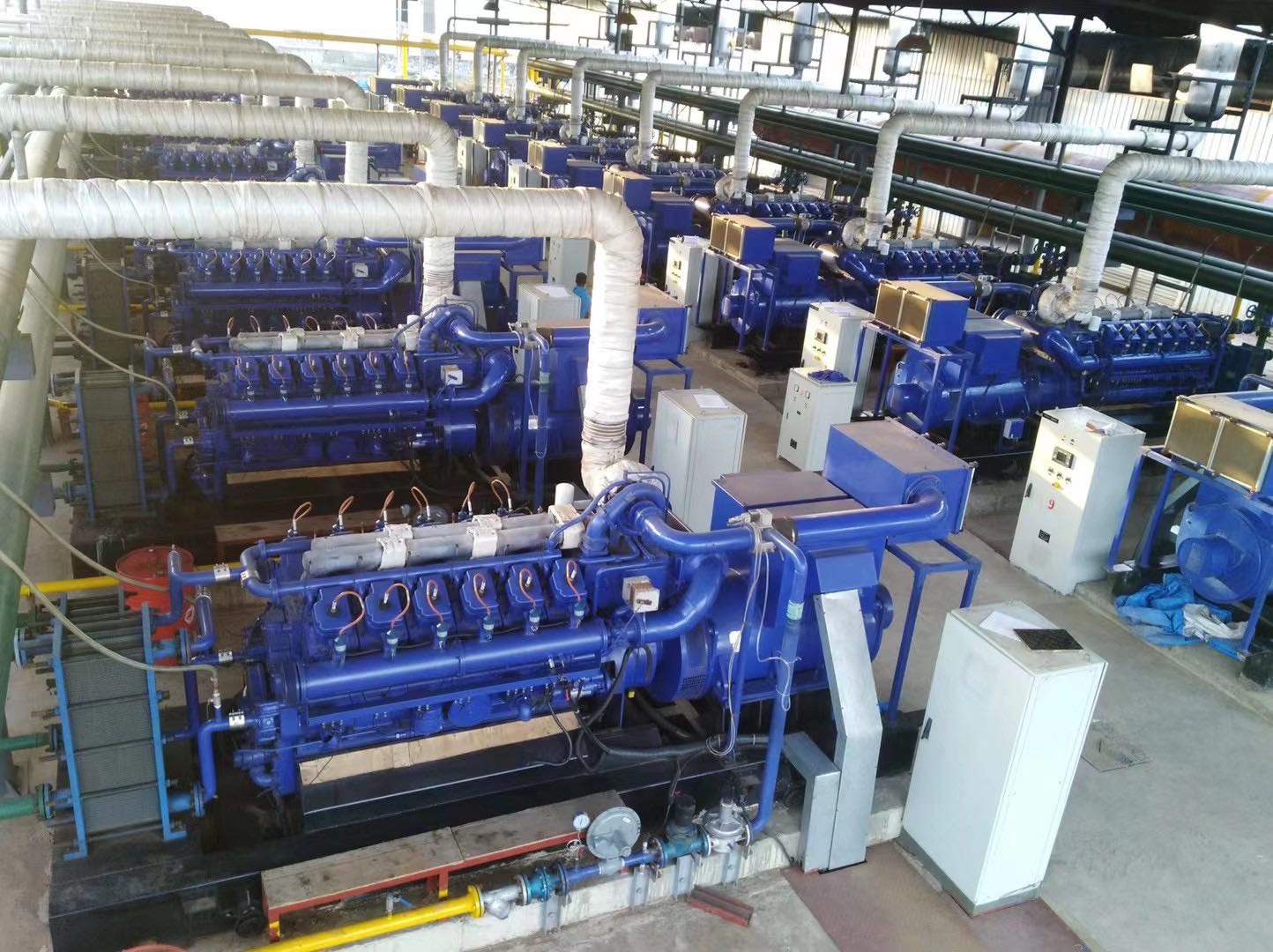 联系 - 热线
联系 - 热线
0531-69953988

 联系 - 热线
联系 - 热线
解析燃气发电机组对燃料的需求
燃气发电机组作为分布式能源系统的核心设备,其运行稳定性与燃料品质密切相关。燃料适配性不仅影响机组热效率,更直接关联设备寿命与排放达标率。本文从燃料成分、物理特性、杂质控制三个维度,深度解析燃气发电机组对燃料的严苛要求。
As the core equipment of distributed energy systems, the operational stability of gas-fired generator sets is closely related to fuel quality. The fuel adaptability not only affects the thermal efficiency of the unit, but also directly relates to the equipment life and emission compliance rate. This article deeply analyzes the strict requirements of gas generators for fuel from three dimensions: fuel composition, physical properties, and impurity control.
一、化学成分的黄金配比
1、 The golden ratio of chemical composition
燃气发电机组对燃料化学成分的要求,本质是燃烧学与材料科学的平衡艺术。以天然气为例,甲烷含量需维持在70%-95%区间,这一范围既保证燃烧热值,又避免过高烷烃导致的积碳风险。当甲烷浓度低于65%时,燃烧室会出现火焰传播速度下降、爆震倾向增加等异常工况,直接导致热效率下降3%-5%。
The requirements of fuel chemical composition for gas generator sets are essentially the art of balancing combustion science and materials science. Taking natural gas as an example, the methane content needs to be maintained within the range of 70% -95%, which ensures the combustion heat value and avoids the risk of carbon deposition caused by excessive alkanes. When the methane concentration is below 65%, abnormal operating conditions such as a decrease in flame propagation speed and an increase in detonation tendency will occur in the combustion chamber, directly leading to a 3% -5% decrease in thermal efficiency.
硫化物控制是燃料适配的关键指标。硫化氢含量需严格控制在20mg/Nm²以下,该数值源自对发动机阀系材料的腐蚀试验数据。当H²S浓度超标时,排气阀座接触面会出现蜂窝状腐蚀,6个月内即可导致密封失效。对于沼气等生物质燃气,氨含量同样需控制在20mg/Nm²以内,以防止硝酸盐沉积引发的缸套磨损。
Sulfide control is a key indicator for fuel adaptation. The content of hydrogen sulfide must be strictly controlled below 20mg/Nm ², which is derived from corrosion test data on engine valve system materials. When the concentration of H² S exceeds the standard, honeycomb corrosion will occur on the contact surface of the exhaust valve seat, which can lead to seal failure within 6 months. For biomass gases such as biogas, the ammonia (NH3) content should also be controlled within 20mg/Nm² to prevent cylinder liner wear caused by nitrate deposition.
二、物理特性的精密边界
2、 Precise boundary of physical properties
燃料压力稳定性直接影响机组负荷响应速度。在0.08-0.30MPa的压力窗口内,压力波动率需≤1kPa/min。某型燃气机组实测数据显示,当压力波动超过±10%时,涡轮增压器喘振频率提升40%,导致轴承润滑油膜破裂风险增加。对于压力波动超标场景,需配置双联稳压阀组,通过压力反馈控制系统实现0.1秒级快速调节。
The stability of fuel pressure directly affects the load response speed of the unit. Within the pressure window of 0.08-0.30MPa, the pressure fluctuation rate should be ≤ 1kPa/min. The measured data of a certain type of gas turbine unit shows that when the pressure fluctuation exceeds ± 10%, the surge frequency of the turbocharger increases by 40%, leading to an increased risk of bearing lubricating oil film rupture. For scenarios where pressure fluctuations exceed the standard, a dual regulator valve group needs to be configured to achieve rapid adjustment in 0.1 seconds through a pressure feedback control system.
温度控制存在双重阈值:供气温度需≥5℃以防止管路结冰,同时要求燃料过热度≥11℃以避免液态烃冷凝。在北方冬季工况中,需在燃料管路设置电伴热系统与气液分离器,确保燃料以气态进入燃烧室。某垃圾填埋气发电项目曾因未设置加热装置,导致燃料在调压阀处结冰,造成机组非计划停机。
There is a dual threshold for temperature control: the gas supply temperature must be ≥ 5 ℃ to prevent pipeline icing, and the fuel superheat must be ≥ 11 ℃ to avoid liquid hydrocarbon condensation. In winter working conditions in the north, it is necessary to install an electric heat tracing system and a gas-liquid separator in the fuel pipeline to ensure that the fuel enters the combustion chamber in gaseous form. A landfill gas power generation project once had an unplanned shutdown of the unit due to the lack of heating devices, resulting in fuel freezing at the pressure regulating valve.

三、杂质控制的纳米级标准
3、 Nano level standards for impurity control
固体颗粒物控制达到微米级精度,要求颗粒直径<5μm且总含量≤30mg/Nm² 。这源于对喷油嘴孔径的适配性要求——现代燃气机组喷油嘴孔径已缩小至0.15mm,大于5μm的颗粒会直接堵塞喷孔。某油田伴生气发电项目因未设置高效过滤器,导致3个月内喷油嘴更换频率达2次/周,运维成本激增300%。
Solid particulate matter control achieves micrometer level accuracy, requiring particle diameter<5 μ m and total content ≤ 30mg/Nm ² . This is due to the requirement for adaptability of the nozzle aperture - the nozzle aperture of modern gas turbine units has been reduced to 0.15mm, and particles larger than 5 μ m will directly block the nozzle aperture. Due to the lack of high-efficiency filters in a certain oilfield associated gas power generation project, the frequency of fuel injector replacement reached 2 times per week within 3 months, resulting in a 300% increase in operation and maintenance costs.
液态杂质处理需构建三级防护体系:初级分离器去除游离水,精密过滤器拦截乳化液,最后通过聚结过滤器实现油水分离。对于焦炉煤气等含焦油燃料,需增设活性炭吸附装置,将焦油含量控制在50mg/Nm² 以下。某钢铁企业案例显示,焦油含量超标会导致涡轮叶片结焦,使机组出力下降15%仅需200小时。
The treatment of liquid impurities requires the construction of a three-level protection system: a primary separator to remove free water, a precision filter to intercept emulsion, and finally, oil-water separation is achieved through a coalescence filter. For tar containing fuels such as coke oven gas, it is necessary to install activated carbon adsorption devices to control the tar content below 50mg/Nm ² . A case study of a certain steel enterprise shows that excessive tar content can cause coking of turbine blades, resulting in a 15% decrease in unit output in just 200 hours.
四、特殊燃料的技术适配
4、 Technical adaptation of special fuels
面对沼气、煤层气等非常规燃料,需进行专项技术适配。沼气发电需配置双膜储气柜,通过生物脱硫将H² S含量降至200mg/Nm² 以下,同时设置焦油裂解装置处理含有的复杂有机物。煤层气发电则需解决低热值难题,通过预混燃烧技术将热值4.2MJ/Nm² 的燃料稳定燃烧,某型机组已实现3.8MJ/Nm² 极限工况运行。
Special technical adaptation is required for unconventional fuels such as biogas and coalbed methane. Biogas power generation requires the installation of double membrane gas storage tanks, which can reduce the H ² S content to below 200mg/Nm ² through biological desulfurization. At the same time, a tar cracking device should be set up to treat complex organic compounds. Coalbed methane power generation needs to solve the problem of low calorific value. By using premixed combustion technology to stably burn fuel with a calorific value of 4.2MJ/Nm² , a certain type of unit has achieved maximum operating conditions of 3.8MJ/Nm² .
燃料适配性技术正在向智能化方向发展。某企业开发的燃料品质在线监测系统,可实时检测CH² 、H² S、颗粒物等12项指标,通过边缘计算调整空燃比,使机组在燃料品质波动20%时仍保持额定出力。这种技术突破,为生物质气化发电等波动性场景提供了解决方案。
Fuel adaptability technology is developing towards intelligence. The fuel quality online monitoring system developed by an enterprise can detect 12 indicators such as CH ² , H ² S, and particulate matter in real time, and adjust the air-fuel ratio through edge computing, so that the unit can still maintain its rated output when the fuel quality fluctuates by 20%. This technological breakthrough provides a solution for volatile scenarios such as biomass gasification power generation.
本文由燃气发电机组友情奉献.更多有关的知识请点击:http://www.zhongtuopower.cn我们将会对您提出的疑问进行详细的解答,欢迎您登录网站留言.
This article is a friendly contribution from the analysis of gas generator sets For more information, please click: http://www.zhongtuopower.cn We will provide detailed answers to your questions. You are welcome to log in to our website and leave a message
业务分类
Business classification产品推荐
product recommendation联系方式
Contact Information

截屏,微信识别二维码